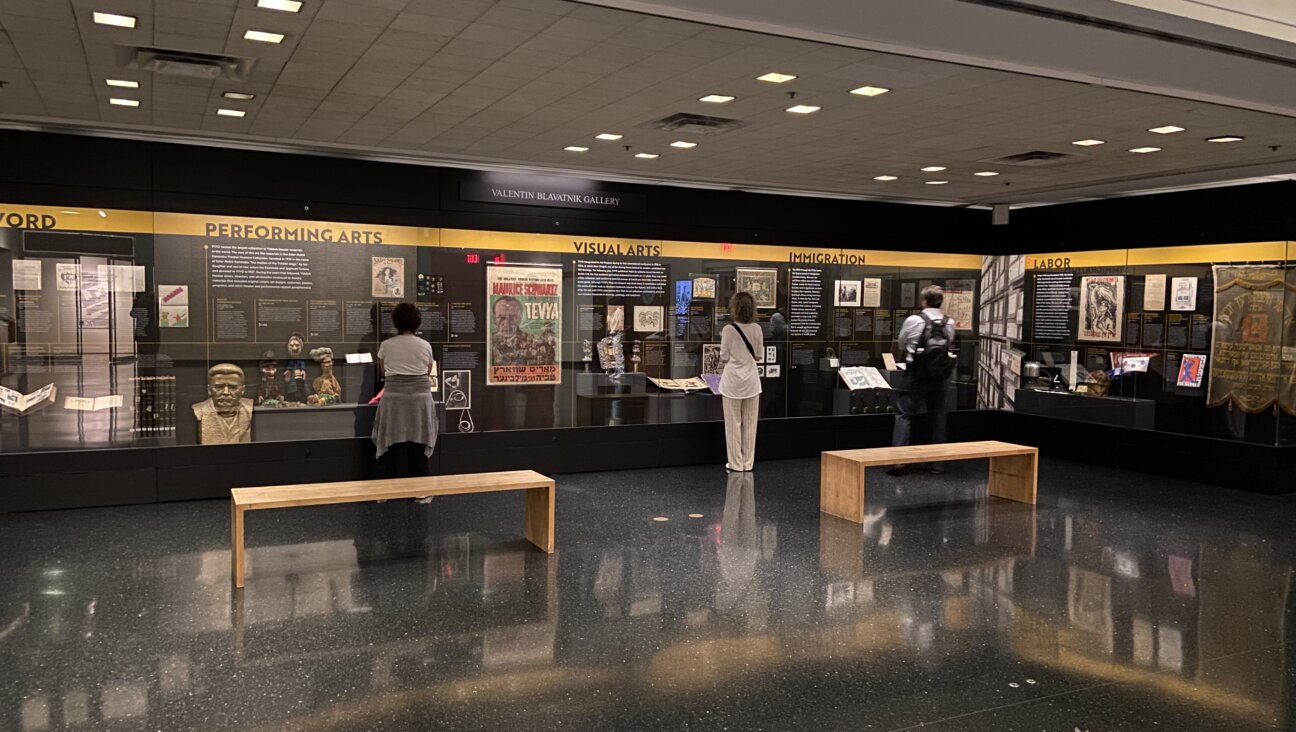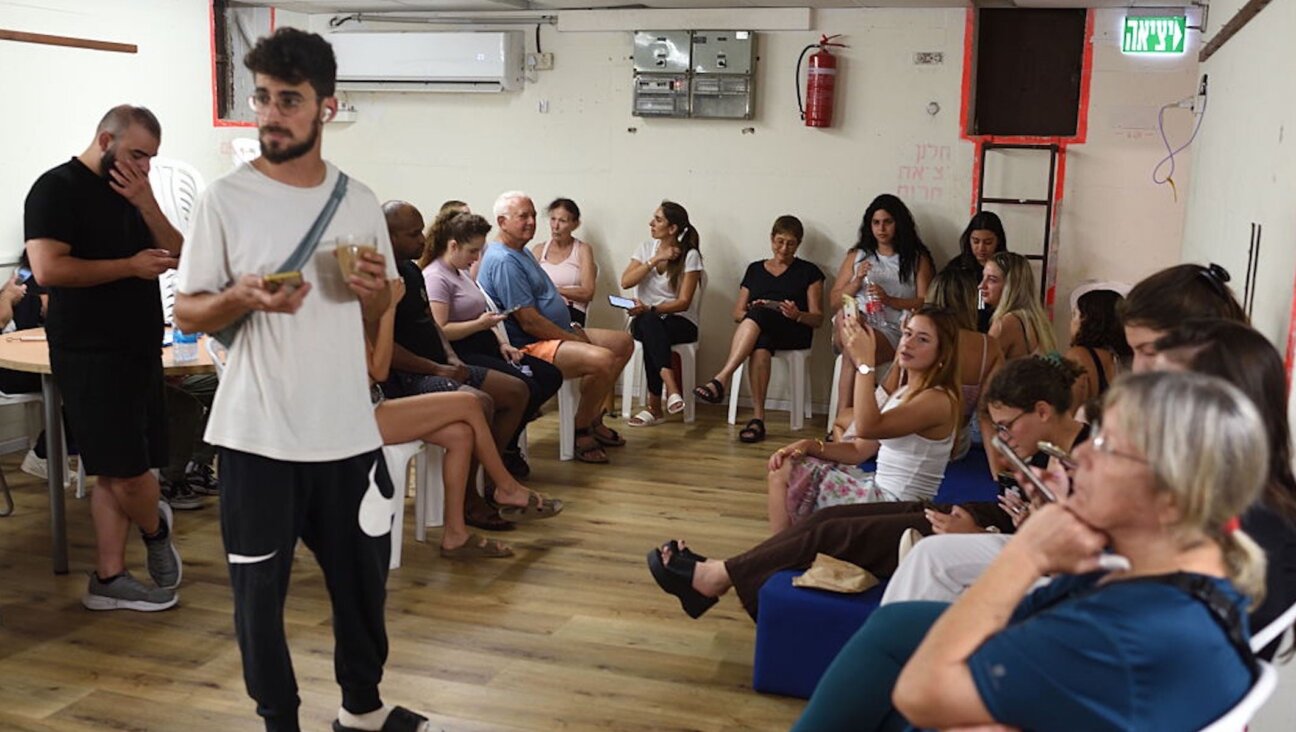EXCLUSIVE: How Poet Emma Lazarus Inspired Laurie Anderson

Laurie Anderson in the home that once belonged to Emma Lazarus. Image by Gemma Solomons
This tale features feminist heroes not normally paired: the 19th-century poet Emma Lazarus and the (very alive) avant-garde musician and artist Laurie Anderson.
Of Emma Lazarus, most know only that she wrote the line “Give me your tired, your poor, your huddled masses yearning to breathe free…” — iconic words emblazoned on the pedestal of the Statue of Liberty. Yet before there was Philip Roth, Saul Bellow, Bernard Malamud and even Isaac Bashevis Singer, Lazarus invented the job of America’s favorite Jewish writer. This former teen prodigy was also one of our earliest activists against xenophobia. Although celebrated in her day for completely different material, she is posthumously known for “The New Colossus,” a sonnet that she had zero idea would forever be linked to the statue.
In a 1950s classroom, those famous words were seared in the mind of Laurie Anderson, an equally precocious child growing up in a landlocked Chicago suburb.
This past Valentine’s Day, Emma Lazarus and Laurie Anderson’s lives collided in the multi-century continuum we call New York.
EVERYTHING YOU NEED TO KNOW ABOUT EMMA LAZARUS

America’s Poet: Emma Lazarus (1849-1887), who wrote ‘The New Colossus’, the poem later engraved on the base of the Statue of Liberty. (Photo by Hulton Archive/Getty Images) Image by Getty Images
Let’s rewind to a hot New York day in 1849 — Sunday, July 22, to be precise. Saturday’s rain has cooled the sweltering island of Manhattan, peopled by 400,000, but now that choking heat is back again.
Do you hear the clip-clop of the horse-drawn cabs, and the omnibuses heading either way on the wide cross street of 14th Street? Horse poop fouls the air, and the more refined pedestrians of this upper middle-class neighborhood carry nosegays and handkerchiefs perfumed with lilacs and violets to cover their noses in case of stink. Here, in the middle of the island, far away from the slaughterhouses and shipyards of the North (later Hudson) River and East River, the windows are open: Yes, that’s the sound of piano from the genteel front parlors.
Now, picture yourself invited into gas-lit 36 West 14th Street, sugar refiner Moses Lazarus’s upscale home. There are servants to get you cider or whiskey. Brownstones near Union Square signal accrued wealth and desirable ancestors.
Moses Lazarus is anxiously awaiting news from the midwife attending to his wife, Esther — or Hetty, as loved ones call her. The man of the house is hoping that after three girls, the fourth child will be a boy to carry his family name. Like most children born in mid-19th-century New York, the child will be born in a bedroom.
Eliezer turned out to be a fourth daughter, Emma, with blue-gray eyes that would keep their color, and brown hair that would one day grow long and wavy.
A whopping 90% of today’s American Jews can trace their lineage to Ashkenazi immigrants. Most Jews who arrived to American shores before the flood of the late 19th-century immigration had a different heritage. Moses Lazarus, descended from the meager 200 Jews that had arrived in New York by 1700, was no impoverished immigrant starting over. That’s early American heritage, but other New York Jews whom he knew well could trace their ancestries back to the first Jews who arrived in 1654, Sephardim who fled the Spanish inquisition, immigrated to London then to the West Indies, before they arrived in New Amsterdam, and soon formed the city’s first synagogue, Shearith Israel, also known as The Spanish & Portuguese Synagogue. This was the synagogue that Emma Lazarus’s wealthy family had always belonged to, and although it had seen several addresses since Dutch rule, the 1860 incarnation of Shearith Israel, then also called the Nineteenth Street Synagogue, was near the Lazarus home, and west of Fifth Avenue, the highest building to be seen above 14th Street. The New York Jewish community numbered 16,000 at the time of baby Emma’s arrival. Many of the urban Jewish elite — even the least religious, like Moses Lazarus, who simply showed up during the High Holidays — were congregants. (The congregation is located today on West 70th Street, just off Central Park.)
Despite the money he raised for the synagogue’s coffers, Moses Lazarus didn’t think much of the Old World religious rules that held him back in business, and, cigar in hand, he hobnobbed daily with mighty sideburned men in smoky rooms forbidden to women; he was that unicorn Jew asked to join the exclusive Republican Union Club — and later a founding member of the equally elite Knickerbocker Club.
Hetty’s mostly German Jewish lineage was nothing to sneeze at; her family was prominent well before the American Revolution. Her brother, Benjamin, was a member of the New York Stock Exchange and a director of Chicago and Northern Railroad; he was bludgeoned to death — you’ll have to Google that incident. Through her maternal side, Emma Lazarus was a first cousin to the prominent lawyer Benjamin Cardozo. Family member Moses Seixas famously corresponded with George Washington in 1790. Hetty’s creative native New York great-grandmother Grace Seixas Nathan wrote poetry she hand-sewed into her own manuscript. Also related on the maternal line was the fiancée of Washington Irving, the colonial beauty Rebecca Gratz, said to be the inspiration for Sir Walter Scott’s enticing Jewess Rebecca in “Ivanhoe.”
But let’s not rewrite history: Moses Lazarus’s money was indirectly made at the expense of slaves. At the time of Emma’s birth, the 36-year-old was the partner of Louisiana plantation and slave-owner Bradish Johnson. They co-owned a distillery on 17th Street between Ninth and 10th avenues, which Johnson had started with plantation profits, and sold the refuse as feed for cows. Sugar was a prominent New York industry of the 19th century, and the partners also invested in a sugar refinery called Johnson & Lazarus; their company was the first to make use of centrifugal machines in the manufacture of sugar. To Moses Lazarus’s credit, the unlikely partners did not get on. History looks less kindly at Johnson, who was cited for abusing slaves. In 1853, he was named in The Daily Times for selling milk that had been tainted by the alcoholic sluice from the distillery. (Over the years, Moses Lazarus had less and less to do with the bastard.)
Lazarus parted ways from the firm at the end of the Civil War in 1865, championing those fighting for abolition, but very rich.
With all that sugar money, Emma Lazarus was privately tutored at home in French, Italian and German. Rich girls in the Gilded Age, even the Jewish ones, fashionably summered in Saratoga Springs, New York and in lavish Newport cottages. When she was a young woman, her father built, for $17,000, a grand second Empire French home on Newport’s Bellevue Avenue, called The Beeches. (It remains a private residence valued at $3 million.)
The spoiled child was lost in purpose. She was not the oldest, not the prettiest, not the son. As with many an introverted book nerd, she was at home in history and fantasy, and her dolls had names taken from King Arthur and mythology. Like her father, this fourth-generation Jew’s closest intimates were non-Jews. Writing about Judaism was not her thing.
Lazarus was 11 when the Civil War broke out in 1861, the same year that she began to write verse. References to the four-year war pops up in her poetry only at the end of the conflict, although the national fight certainly affected her family. There were few copperheads (the Peace Democrats, who championed compromise over warfare) in the New York Jewish community, and some of her uncles and male cousins enlisted for the union cause.
A year after the war, in 1866, Lazarus’s private male tutor was so enthralled by her growing literary chops (a source of amusement to her sisters and younger brother) that he convinced Moses Lazarus to arrange for a vanity publication for his talented fourth daughter; although she was only 17, Moses Lazarus was a proud father not hard to convince. A gift to the intense, slightly homely child was but a blip in his ample bank account. Her ensuing 200-page book (wisely dedicated to her father) was called “Poems and Translations: Written Between the Ages of Fourteen and Sixteen.” He handed it out to many people; a legitimate house called Hurd and Houghton (a corporate predecessor to today’s Houghton Mifflin Harcourt) published it a year later, when Emma Lazarus was 18.
Not only did her properly published book receive a kind write-up in The New York Times, news of Lazarus’s friendship with the right people also spread. Eventually, expatriate Boston friends of Ralph Waldo Emerson living in New York sent a signed copy of her book to the 19th-century influencer.
“I would like to be appointed your professor, you being required to attend the whole term,” Emerson wrote her in a problematic and domineering letter that would raise eyebrows today in the #MeToo era. But he kept his word: The 63-year-old did become a mentor to the teen he called “Miss Emma.” In 1868, through the Wards, the same friends who had sent Emerson him the book by post, Emma Lazarus and her father met the great man at their home on Madison Avenue.
Emerson and Emma Lazarus had a falling-out after she resisted his attempts to muffle her emerging style. One nasty comment read, “You permit feeble lines and feeble words….” However, she dedicated her novel “Alide: An Episode of Goethe’s Life ” to him; perhaps that was a clever chess move as opposed to subservience. They had a sort of detente as the years went by, especially when she heard he was in mental decline.
Like many writers of then and now, Emma Lazarus had a deep appreciation of naturalist Henry David Thoreau, who was sadly more famous after his death in 1862 than when he was alive. In 1876, while visiting Concord, Massachusetts, to cheer the ailing Emerson (now in the first stages of Alzheimer’s), this dyed-in-the-wool New Yorker rambled about Walden Pond with Thoreau’s old friend William Ellery Channing, the 58-year-old eccentric who had become Thoreau’s biographer. Channing even gave her the pocket compass that Thoreau used to navigate the Maine woods. (Imagine if that long-lost knickknack showed up on “Antiques Roadshow!”)
Back then, Lazarus was still far from a Jewish poster child. Anti-immigration rhetoric was on the rise, and the nationalistic Americans looked on the Revolutionary-era Jews, like the Lazarus and Nathan families, as the only “true Hebrews.” Perhaps Lazarus’s moneyed family experienced that subtle anti-Semitism synonymous with the Ivies, where if you are a Jew with enough L.L. Bean orders, you are almost in. Almost. Like her father, Emma Lazarus identified as secular, and felt both connected to the Jewish people and somewhat apart from them. “I shall always be loyal to my race, but I have no religious fervor in my soul,” she wrote to Gustav Gottheil, the influential Reform rabbi at posh Temple Emanu-El, after he’d asked for a bit of writer’s help on a new prayer book.
To even the snobbish Jews, worth dropped in rungs until you got to the peasant immigrants.
But soon, a culturally disengaged woman (who observed Christmas and spent Friday nights at the bohemian studio salons of Helena de Kay Gilder and Richard Watson Gilder) was shaken by the news coming out of Russia.
The March 13, 1881 assassination of Alexander II by Narodnaya Volya was attributed to Jews by the Russian government. The first news reports of the murder, massacre and rape of Jews in the Russia pale hit that June; just months earlier, the most elite and secular Jews in the city had planned a merging with the Unitarian church. Souls were searched, including Lazarus’s. Over several visits tagging along with other wealthy do-gooders, she came face to face with some of the 2,000 Russian Jewish immigrants arriving monthly, traumatized survivors fleeing their shattered communities and now holed up in temporary rundown barracks on Ward’s Island in the northern East River. From nowhere to nowhere.
So powerful were these encounters with the ghetto Ashkenazi that Lazarus soon had a clear-eyed view of the threats to her people both abroad and in the vile clang of nationalism at home. Refugees were later met with help in New York, in no small part due to her thematic poems and advocacy journalism.
In May 1882 an article called “Russian Christianity Versus Modern Judaism” appeared on the pages of The Century Magazine. In it, Lazarus was battling a nasty article The Century had published the month before by a Madame Ragozin — solicited to drive controversy and sales — and a piece that read like a 19th-century version of “The Protocols of the Elders of Zion.” This so-called historian and author was an outright defender of the pogroms, a woman who, like many a commentator on Fox News of today, dehumanized the neediest immigrants. Among her ugliest words, “In all cases, Jewish riots begin spontaneously.”
Like an ancestral member of The Incredibles, Lazarus wasn’t done with intellectually leveling a shameful anti-Semite. She helped organize Jewish philanthropies like the Hebrew Technical Institute in New York, and she was also an early supporter of equal rights for women. If that was all, dayenu. But then, inspired by George Eliot’s 1876 Zionist novel “Daniel Deronda,” which featured a sympathetic Jewish protagonist championing a Jewish state, Lazarus crusaded for a Jewish homeland in Palestine, 13 years before Theodor Herzl, who is often called the spiritual father of the Jewish State. (When speaking of her literary idol, George Eliot, she always referred to her by her real name, Mary Ann Evans.)
She had less success navigating love. Under the watchful eye of her father, Lazarus remained the unmarried talent that could keep him good company. In 1883, after a brownstone rental stint at East 57th Street, Moses Lazarus moved back downtown to a swankier home on 18 West 10th Street. This Italianate-style roseate brownstone, now all his, had been completed by James Renwick (best known for the Smithsonian) in 1856 for Margaret L. Winslow, and later owned by other families before the Lazarus dynasty bought it. In the past, several houses, including 18 West 10th Street, have been called English Terrace Row; today, architects call the series of fine brownstones Renwick Row. Near to this home is another masterpiece of Renwick’s, Grace Church.
Emma Lazarus would live in these deluxe digs for only one year. But it was the year she would write her most famous poem about a certain peace gift that was designed by Frédéric Auguste Bartholdi and had not yet arrived from France.
Originally, the statue to be bestowed upon the American people, formally called Liberty Enlightening the World, was intended to commemorate the abolition of slavery after the Civil War as well as the U.S.-French friendship during the American Revolution. Back in 1865, French anti-slavery activist Edouard de Laboulaye had proposed that his nation should gift a statue on these themes, and French sculptor Bartholdi was intrigued by the idea and ran with it.
Liberty’s head and arm (with torch) hit American shores to whet the appetite for the whole statue; her arm was exhibited in Philly’s 1876 Centennial Expo, and then in Manhattan’s Madison Square from 1876 to 1882.
The rest of the 225-ton statue would arrive in 1885 in 214 crates, and with a pedestal it was supposed to reach 205 feet. The French people would provide for the statue portion through charity drives. What Bartholdi and his nation would not cough up for was the $280,000 needed for the construction of a pedestal on what was then called Bedloe’s Island. Enthusiastic Americans took up the cause. In 1883, Constance Cary Harrison, author of plays and novels and a fellow social activist, approached Emma Lazarus. Harrison was putting together a souvenir journal to be part of a benefit art auction organized by J. Carroll Beckwith and William Merritt Chase, instructors at The Art Students League. Harrison wrote: “I begged Miss Lazarus to give me some verses appropriate to the occasion. She was at first inclined to rebel against writing anything ‘To order’ as it were.”
Harrison had already hit up prominent artists and writers like Henry Wadsworth Longfellow, Mark Twain, Walt Whitman and Bret Harte, who specialized in short stories about the California Gold Rush. Like many of Lazarus’s friends, Harrison was not at all Jewish, but like a top Jewish fundraiser — with a lot of chutzpah and a smile — she got them to say yes.
According to Harrison’s account, which may be, shall we say, a tad embellished, she heroically brainstormed, “Think of that goddess standing on her pedestal down yonder in the bay, and holding her torch out to those Russian refugees of yours you are so fond of visiting at Ward’s Island.” Then, again per Harrison’s self-congratulatory account, “… her dark eyes deepened — her cheeks flushed — the time for merriment was passed. She said not a word more, then.”
Well, she must have said something right. Two days after Harrison mentioned the goddess, Lazarus came through with “The New Colossus.” Emma gave the statue a different spin than the original idea behind it, calling the copper lady the Mother of Exiles and, for the first time, linking immigration to Lady Liberty’s story.
Many took up the cause after Harrison; the most famous was newspaper publisher Joseph Pulitzer, who made daily appeals on his New York World pages for extra pennies from his readers. The pedestal, designed by renowned architect Richard Morris Hunt, was completed in April 1886. The dedication of the statue was shortly thereafter, by Grover Cleveland; it was a dull brown statue that had not yet turned green from decades of weathering. Not only was “The New Colossus” never mentioned, but Lazarus was far away from the celebration, traveling in Europe — and feeling weaker every day until making a sad return.
Back in her home in Manhattan’s Greenwich Village, on West 10tth Street, she died at 11 a.m. Saturday, November 19, 1887. Obituaries mention congestion of her lungs, but later historians understood her disease to be cancer — more precisely, Hodgkin’s lymphoma.
After a quiet, simple 10 a.m. service in her new West 10th Street home, by the Rev. Henry Pereira Mendes, chief rabbi of Shearith, Emma Lazarus was interred in the rural Beth Olom cemetery on the Brooklyn-Queens border of Cypress Hills.
In 1901, 14 years after Lazarus’s death, poetry had moved on. Celebrated books of the previous decades were looked upon as weighted down with frowzy verse.
But one day her old friend Georgina Schuyler (the granddaughter of Alexander Hamilton) was in a bookshop and uncovered a tome containing her friend’s mostly forgotten poem “The New Colossus.” Schuyler was so moved that she organized a civic effort to resurrect the lost sonnet, and the public attention greatly embarrassed the living members of the Lazarus family as crass.
By 1903, despite the Lazarus family trying to stop the nonsense, words from the sonnet were inscribed on a simple Tiffany bronze plaque gifted by Georgina Schuyler. The poem was affixed to the 89-foot pedestal’s interior wall and placed on the inner wall of the pedestal of the Statue of Liberty.
The statue gained national monument status under President Coolidge in 1924 when xenophobia was on the rise and bigots slammed the door shut on those seeking refuge. New laws favoring Anglo-Saxon whites of “desirable” countries required that new immigrants be no more than 2% of the immigrant community already in the country. The Jewish, Slav and Italian refugee population dropped dramatically. Because of these prejudicial laws, it was harder for Jews to escape the rising terror of the Nazi Party.
It was not until the 1930s, near the 50th anniversary of the statue, that the poem took hold. A letter to the editor complained about no mention of Emma Lazarus in the coverage and included all the words. Social champion Louis Adamic quoted the poem at every opportunity, championing immigrants and singing the poem’s praises. In 1945, the plaque was moved to the statue’s main entrance hall.
1949 saw the Broadway debut of Irving Berlin’s “Miss Liberty,” which set the final lines of “The New Colossus” to music. The poem was now firmly in popular culture.
BAGELS AND LOX INTERLUDE

Annie Polland of AJHS with Laurie Anderson. Image by Gemma Solomons
As a first act after landing a new post at the American Jewish Historical Society, AJHS’s new executive director, Annie Polland, knew she wanted to do a large long-term exhibit and recruit someone spectacular to read Lazarus’s work — AJHS is steward of her papers. Additional future plans for AJHS include an exhibit that will be called “From Sitting Room to Soapbox” and will transform the 270-square-orientation center at the entrance of the Center for Jewish History into Lazarus’s 19th-century brownstone sitting room. (CJH houses five major organizations, including AJHS.) That forthcoming exhibit will also project “The New Colossus” on one of the exhibit walls.
But who would best inhabit Lazarus for a recording of her most famous poem? Whoever she recruited would launch the first step toward a larger push to make Lazarus well known, one that will launch online near May 5, to mark when the plaque was installed at Bedloe’s Island on Tuesday, May 5, 1903.
Polland immediately thought of Laurie Anderson, with whom she had worked before: After Lou Reed’s death, his widow had come to the Tenement Museum, Polland’s previous not-for-profit home, to discuss her husband’s 2010 short film on his 100-year-old cousin who fled Germany and lost parents to the Nazis.
“Who better to record America’s most enduring poem than an iconic voice? Of course, immigration rights have always been important to her, too. It was a match made in heaven,” Polland said.
Back when she headed the Tenement Museum, Polland had first connected with Anderson through New York City’s legendary Lower East Side appetizing store Russ & Daughters, which counts Anderson among its most loyal customers. “An ex-manager [Jeremiah Cymerman] there got us in touch. It was a very old New York connection,” she said.
Wait? Laurie Anderson knows from lox? Maybe it was the Reed influence: Reed was bar mitzvahed at Freeport, New York’s conservative congregation B’nai Israel as Lewis Allen Reed aka Levi ben Yossef. However, had she not gained her love of appetizing, she would never have been asked to channel Lazarus, and to do so in Lazarus’s former home.
WHERE LAURIE ANDERSON MEETS EMMA LAZARUS

Liberty Enlightening The World: An engraving from the 19th century. From ‘La Ilustracion Espanola y Americana’ published in Spain. (Photo by GraphicaArtis/Getty Images) Image by Getty Images
Laurie Anderson arrived in the world in Wayne, Illinois, on June 5, 1947, the second of eight children of Mary Louise Rowland and Arthur T. Anderson. Soon the large Swedish and Irish family moved to nearby Glen Ellyn, an all-American town with a train station and fountain, just 24 miles west of Chicago. Like Lazarus, she had special training as a child, coupled with unusual ability. She started playing the violin at 5, and was also enrolled in Saturday art classes at the School of the Art Institute. At home she had an eccentric childhood, with a menagerie of various dogs, cats, donkeys and burros and a squirrel monkey. At Glenbard West High School she was involved in school politics, was an actor in class plays and was even a cheerleader. In her 1965 yearbook she had eight lines of interest and honors. But through books, television and film, New York made itself known in her imagination.
She first went to Mills College, in California, and eventually graduated magna cum laude and Phi Beta Kappa from Barnard College in 1969, with a Bachelor of Arts. and in art history. In 1972 she obtained an Master of Fine Arts in sculpture from Columbia University. Her first job was as an art history teacher.
I gleaned all this background on my IPhone while trying to look invisible on a very expensive chair: a documentary crew was setting up for her arrival in Lazarus’s former home at 18 West 10th Street. The former Lazarus home is anything but a museum. It is a private, eye-popping, five-story townhouse that even in its present incarnation evokes the Gilded Age.
An author as famous as Lazarus was in her day now owns the home: writer and cultural critic Andrew Solomon.
Dressed in an impeccably tailored suit, Solomon stopped in the downstairs room dominated by a medieval tapestry you would expect to see in the Cloisters. This room adjourns the library of my dreams, a double-height library with a catwalk. I’ve never seen a more magnificent home library in New York City, and before getting out of the way for the film crew setup, I peeked to see how Solomon organizes: alphabetically within topic.
“All okay?” Solomon asked Polland, who thanked him profusely for letting a film crew into the space. Solomon understands the historical significance of the home he shares with his husband and their son, George, who lives with them full time.
When Solomon purchased the home in 1992 it had long lost much of its grandeur. He did not move in until in 1996, after an extensive and expensive renovation by the French architect Robert Couturier. “Dilapidated isn’t the word for it,” he told me. “I even found a dead cat.”
It’s not like money to fix it up was an issue. Solomon is heir to the Forest Pharmaceutical fortune, which, when sold, yielded billions.
Solomon, a native New Yorker, is part of the rare breed of accomplished men who, like Anderson Cooper (son of Gloria Vanderbilt), do not rest on their fortunes; in addition to his enviable career as a writer and academic, he is a past president of PEN American Center a not-for-profit organization that fights for freedom for writers.
Solomon didn’t seem fazed by rumors of the ghost of Emma Lazarus having been spotted, but he had to excuse himself for a phone call.
The doorbell then rang, and the film crew and Polland’s staff stood at attention. Fresh off her first Grammy win, at 71, Anderson was casually dressed in jeans and plaid shirt, and a gray sweater with an eye-catching floral design. Nobody has Laurie Anderson’s memorable spiky hairstyle, high cheekbones and disarming smile. I remembered the exact moment I’d previously “met her” when I was a sophomore in high school, when her spoken-word piece “O Superman” was in heavy rotation on MTV 37 years ago.
When it was my turn to introduce myself, I said I have always told people that I spell my Laurie like Laurie Anderson – L A U R I E. She laughed and said, “I spell my Laurie that way too!”
Laurie Anderson in person sounds like Laurie Anderson on MTV, as melodious as she is Midwestern. And she still seems aglow.
The living room with tapestry library and the catwalk equally impressed Anderson: “Wow! Just wow!”
Before we began, she took out a camera and climbed the wrought iron catwalk stairs to the upper tier for her own look-see and maybe a few shots for her many Instagram followers.
Solomon reappeared and said he was so delighted that Anderson could visit his home, and he was off to a meeting.
In the pre-interview that may eventually be integrated into the final presentation, Anderson remembered back to when she was as a child: “I’m pretty sure we read the poem in our elementary room, maybe even with a hand over our hearts.” The idea of a shore where immigrants arrived stuck with her, and it resonates with her even more in 2019.
She said she could see the statue every day from the window of her place near the West Side Highway.
And then the poetry recording of “The New Colossus” began. The documentary had several ways to record in the allotted time. Anderson read off cue cards consisting of giant sheets of paper with parts of the poem.
Not like the brazen giant of Greek fame,/ With conquering limbs astride from land to land;/ Here at our sea-washed, sunset gates shall stand/ A mighty woman with a torch, whose flame/ Is the imprisoned lightning, and her name/ MOTHER OF EXILES. From her beacon-hand/ Glows worldwide welcome; her mild eyes command/ The air-bridged harbor that twin cities frame./ “Keep, ancient lands, your storied pomp!” cries she/ With silent lips. “Give me your tired, your poor,/ Your huddled masses yearning to breathe free,/ The wretched refuse of your teeming shore./ Send these, the homeless, tempest-tost to me,/ I lift my lamp beside the golden door!”/
MORE LOX
Once the camera was off, Anderson spoke to the crew about another memory this experience had brought up for her. Did they know that Reed’s song “Dirty Blvd” is a reinvention of the most famous Lazarus poem? She knew the lyrics by heart, and quoted a specific stanza: ”Give me your hungry, your tired your poor I’ll piss on ’em;/ That’s what the Statue of Bigotry says. Your poor huddled masses, let’s club ’em to death/And get it over with and just dump ’em on the boulevard.”
Her job well done, she was sure to take home some leftover lox and bagels, no doubt pleasing the ghost of Emma Lazarus, too.
Schmearing cream cheese on a bagel down in Andrew Solomon’s kitchen basement (which is Architectural Digest fabulous, too), Anderson now said she sees Emma Lazarus in the context of her time, comprehending how America has both welcomed and restricted immigration. She also said that she better understood what empathetic Americans need to do to carry on her legacy.
But then, something caught Anderson’s eye: “Ooh, pastrami lox!”
This article was supported in part by the generosity of the 21st Century ILGWU Heritage Fund
Laurie Gwen Shapiro’s most recent book is “The Stowaway: A Young Man’s Extraordinary Adventure to Antarctica.”























